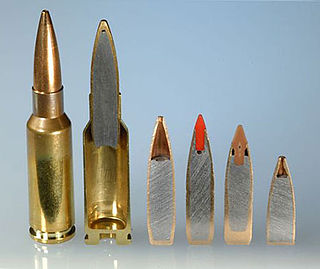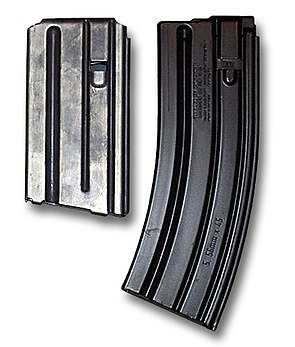
The 5.56×45mm NATO is a rimless bottlenecked intermediate cartridge family developed in the late 1970s in Belgium by FN Herstal. It consists of the SS109, SS110, and SS111 cartridges. On 28 October 1980 under STANAG 4172 it was standardized as the second standard service rifle cartridge for NATO forces as well as many non-NATO countries. The 5.56×45mm NATO cartridge family was derived from and similar in dimensions to the .223, but is not totally identical to the .223 Remington cartridge designed by Remington Arms in the early 1960s.

The Colt AR-15 is a lightweight, 5.56×45mm, magazine-fed, gas-operated semi-automatic rifle. The "AR” stands for ArmaLite Rifle. It was designed to be manufactured with extensive use of aluminum alloys and synthetic materials. Colt was but no longer is marketing to civilian customers and is presently only marketing to law-enforcement customers, due to oversaturation in the civilian market. Colt's Manufacturing Company currently uses the AR-15 trademark for its line of semi-automatic AR-15 rifles.

The .45 ACP or .45 Auto (11.43×23mm) is a rimless straight-walled handgun cartridge designed by John Moses Browning in 1904, for use in his prototype Colt semi-automatic pistol. After successful military trials, it was adopted as the standard chambering for Colt's M1911 pistol. The round was developed due to a lack of stopping power experienced in the Moro Rebellion using the .38 Long Colt. This experience and the Thompson–LaGarde Tests of 1904, led the Army and the Cavalry to decide a minimum of .45 caliber was required in a new handgun.
The La France M16K is a M16 rifle modified by the company La France Specialties, which among with other firearm-related activities, convert common military weapons into more compact configurations typically for law enforcement and special forces use.

The .223 Remington is a rifle cartridge, developed in 1957 as a commercial hunting bullet for small mid-western varmint. Used as a test round for the ArmaLite's newer combat rifle in 1964, the ArmaLite AR-15 was adopted by the United States Army as the M16 rifle, The military version of the cartridge uses a 55-gr full metal jacket bullet and was designated M193. In 1980, the .223 Remington was transformed into a new cartridge, a 62-gr full metal jacket bullet with a 7-gr steel core for better penetration and designated 5.56×45mm NATO.

Eugene Morrison Stoner was an American firearms designer who is most associated with the development of the ArmaLite AR-15 rifle that was modified by the US military as the M16 rifle.

A wildcat cartridge, often shortened to wildcat, is a custom cartridge for which ammunition and/or firearms are not mass-produced. These cartridges are often created in order to optimize a certain performance characteristic of an existing commercial cartridge.

The 6.8mm Remington Special Purpose Cartridge is a rimless bottlenecked intermediate rifle cartridge that was developed by Remington Arms in collaboration with members of the U.S. Army Marksmanship Unit, United States Special Operations Command to possibly replace the 5.56 NATO cartridge in a Short Barreled Rifle(SBR)/Carbine.
The RK 95 TP, officially 7.62 RK 95 TP and commercially known as the M95, is a 7.62×39mm Finnish assault rifle adopted in relatively small numbers by the Finnish Defence Forces in the 1990s. The RK 95 TP originally featured many improvements including a fire control selector and a muzzle device that enabled the firing of rifle grenades, the attachment of a suppressor, or bayonet.

The two most common assault rifles in the world are the Soviet AK-47 and the American M16. These Cold War-era rifles have been used in conflicts both large and small since the 1960s. They are used by military, police, security forces, revolutionaries, terrorists, criminals and civilians alike and will most likely continue to be used for decades to come. As a result, they have been the subject of countless comparisons and endless debate.

The 6.5mm Grendel (6.5×39mm) is an intermediate cartridge designed by Arne Brennan, Bill Alexander and Janne Pohjoispää as a low-recoil, high-accuracy cartridge specifically for the AR-15 platform at medium/long range. It is an improved variation of the 6.5mm PPC. Since its introduction, it has proven to be a versatile design and is now expanding out into other firearms including bolt-action rifles and the Kalashnikov system.

A STANAG magazine or NATO magazine is a type of detachable firearm magazine proposed by NATO in October 1980. Shortly after NATO's acceptance of the 5.56×45mm NATO rifle cartridge, Draft Standardization Agreement (STANAG) 4179 was proposed in order to allow NATO members to easily share rifle ammunition and magazines down to the individual soldier level. The U.S. M16 rifle's magazine proportions were proposed for standardization. Many NATO members, but not all, subsequently developed or purchased rifles with the ability to accept this type of magazine. However the standard was never ratified and remains a "Draft STANAG".
22 caliber, or 5.6mm caliber, refers to a common firearms bore diameter of 0.22 inch (5.6 mm).

The .300 AAC Blackout, also known as 7.62×35mm is an intermediate cartridge developed in the United States by Advanced Armament Corporation (AAC) for use in the M4 carbine. Its purpose is to achieve ballistics similar to the 7.62×39mm cartridge, or even more similarly, the 7.92×33mm Kurz cartridge in an AR-15 while using standard AR-15 magazines at their normal capacities. 300 BLK ammunition cannot be used in a rifle chambered for 7.62×40mm Wilson Tactical. It is mainly derived from the .300 Whisper concept, but differs in having been submitted to the SAAMI.

The 7.62×51mm NATO is a rimless bottlenecked rifle cartridge developed in the 1950s as a standard for small arms among NATO countries. It is sometimes confused with the similarly named Russian 7.62×54mmR cartridge, a slightly longer, rimmed cartridge.

The FN 5.7×28mm (designated as the 5.7 × 28 by the C.I.P.) is a small-caliber, high-velocity, smokeless powder, rebated rim, bottlenecked centerfire cartridge designed for handgun and personal defense weapon (PDW) uses and manufactured by FN Herstal. It is similar in length to the .22 WMR (5.7×27mm) and to some degree similar also to .22 Hornet or .22 K-Hornet. Unlike many new cartridges, it has no parent case; the complete package was developed from scratch by FN.

A silencer, also known as a sound suppressor, suppressor or sound moderator, is a muzzle device that reduces the acoustic intensity of the muzzle report and eliminates muzzle flash when a gun is discharged, by modulating the speed and pressure of the gas ejection from the muzzle and hence suppressing the muzzle blast. Like a muzzle brake, a silencer can be a detachable accessory mounted separately onto the muzzle, or an integral part of the barrel.
The .277 Wolverine (6.8×39mm) is a wildcat cartridge. It is a multi-purpose mid-power cartridge with increased ballistic performance over the AR-15's traditional .223 Remington cartridge requiring only a new barrel to upgrade/convert any 5.56-based firearm to .277 Wolverine.














